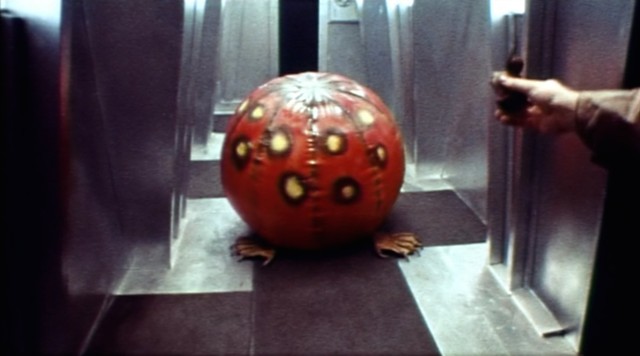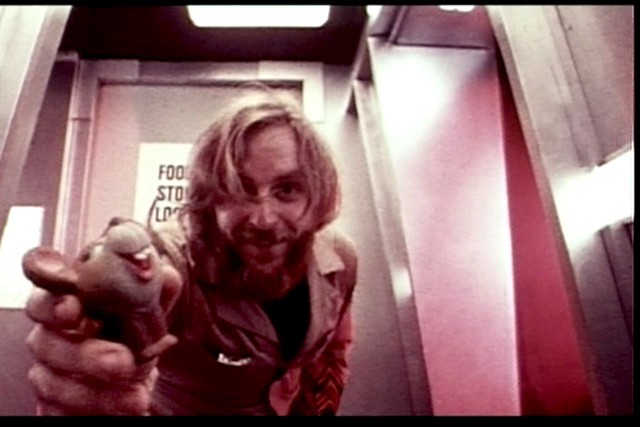
- Bryanston Pictures / Jack H. Harris Enterprises / University of Southern California
- Lt. Doolittle doing a little cosmic surfing in Dark Star
This film has nothing whatsoever to do with Dark Star Orchestra, the jam band that operates under the credo “continuing the Grateful Dead concert experience.”
Glad we got that out of the way.
I dislike jam band music, but I’m a longtime fan of Dark Star, and of John Carpenter in general. I hadn’t seen this particular movie in 15 years or so, and was delighted to find it as clever and enjoyable as I remembered it.
Dark Star is an ultra-low-budget (about $55,000, a pittance for a feature film, even in 1974) sci-fi comedy that skewers such overly serious science fiction films of the day as 2001: A Space Odyssey and Solaris. Like those films, Dark Star addresses the mental-health repercussions of protracted interstellar journeys on those who undertake them; unlike those films, it plays that subject for comedy.

- Bryanston Pictures / Jack H. Harris Enterprises / University of Southern California
- Pinback at the controls in Dark Star
All goes well until a computer malfunction results in one of the bombs failing to detach from the ship before its detonation sequence begins. The comic highlight of the film is the scene in which Lt. Doolittle gives the bomb a crash course in phenomenology: His intent is to convince the bomb that the sensory data on which it makes its decisions are arbitrary and unprovable, and that therefore the bomb should consider not blowing up while still attached to the spacecraft. That goes well for a time; soon it goes horribly, but humorously, wrong.
Dark Star was made when Carpenter and the film’s cocreator, Dan O’Bannon (who would later write Alien and Total Recall, among other excellent films), were still attending the University of Southern California film school. It was shot on 16mm film, and ran just 68 minutes. After it received a bit of attention, a film producer named Jack H. Harris chipped in with the money to make 15 minutes’ worth of additional scenes, which boosted the film up to proper feature length. Though Harris’ investment in the film certainly brought it to the attention of many more people than would otherwise have seen it, Carpenter has reportedly stated that he felt the additional scenes were so much unnecessary padding.
Despite its small budget, Dark Star boasts some clever special effects and set design of the “less is more” variety. The movie is famous for, among other things, turning a painted beach ball and a pair of rubber monster gloves into a more or less believable alien. (That’s the great thing about putting aliens in your movies: No one has ever seen one, so you can make them look however you want without having to answer the nonsensical charge that they don’t look “believable.”)

- Bryanston Pictures / Jack H. Harris Enterprises / University of Southern California
- Hey, it's as "believable" as any other cinematic alien.
I hadn’t watched my DVD of Dark Star in some time, so I’d forgotten that it contained two versions of the film: the original 68-minute cut; and the “extended cut” that includes the 15 minutes of additional footage. Pressed and released in 1999, near the beginning of the DVD era, my disc of Dark Star contains a curious little media artifact that got me thinking about how quickly the digital revolution has changed the way we watch films.

- Bryanston Pictures / Jack H. Harris Enterprises / University of Southern California
- Talby in his bubble in Dark Star
At four or five points during my viewing of the film, the DVD stuttered and paused awkwardly, and I couldn’t figure out why. I checked the time code, and none of these apparent errors skipped over any of the film’s running time. Then I figured it out: The stutters were the moments when the DVD was programmed (by my selection of “original version” from the main menu) to skip over the scenes added in the “Harris cut” of the movie. By selecting “original version,” I had told the DVD player to play only a certain number of the chapters on the disc. It was the player skipping over the added footage that caused those skips.

- Bryanston Pictures / Jack H. Harris Enterprises / University of Southern California
- Pinback lures the alien with a toy mousie.
And, once I figured out what was causing the skipping, I decided I rather liked this little imperfection. It reminded me of my days as an avid viewer of LaserDiscs, when a viewing of any feature-length film was interrupted by having to flip the disc over — or, if you had a later-model LD player like I do, by the 10-second pause during which the laser assembly swiveled from Side A to Side B inside the player. I appreciated that little pause because it brought home the materiality of the version of the film I was watching. It made me appreciate the complexity of the media industries that allowed me to watch the film in the comfort of my own home — something that, even a generation earlier, was impossible without a projector and a private screening room.
I felt the same way about the stuttering of the Dark Star DVD. It’s just one more thing to enjoy about the film.
Speaking of...
-

Student Film Documents Failed Plan to Cut Books From Vermont State University Libraries
Apr 29, 2024 -

A New Film Explores Vermont’s Unsung Modernist Buildings
Mar 20, 2024 -

A Film Critic Pays Final Respects to the Palace 9
Nov 11, 2023 -

Director Jay Craven Wins 10th Annual Herb Lockwood Prize
Oct 21, 2023 -

Book Review: 'Save Me a Seat! A Life With Movies,' Rick Winston
Aug 30, 2023 - More »






Comments
Comments are closed.
From 2014-2020, Seven Days allowed readers to comment on all stories posted on our website. While we've appreciated the suggestions and insights, right now Seven Days is prioritizing our core mission — producing high-quality, responsible local journalism — over moderating online debates between readers.
To criticize, correct or praise our reporting, please send us a letter to the editor or send us a tip. We’ll check it out and report the results.
Online comments may return when we have better tech tools for managing them. Thanks for reading.